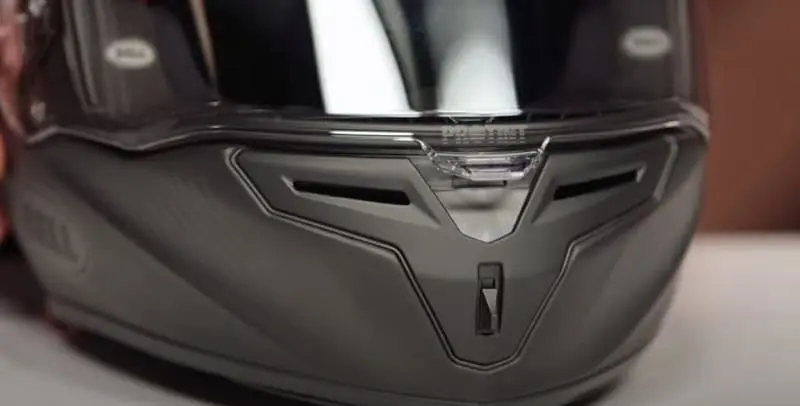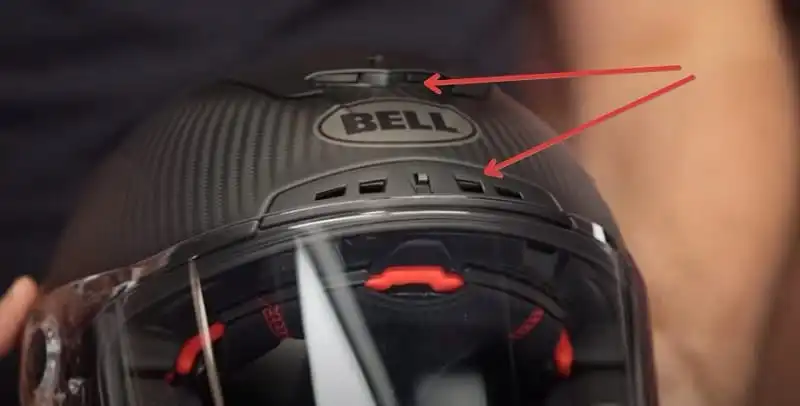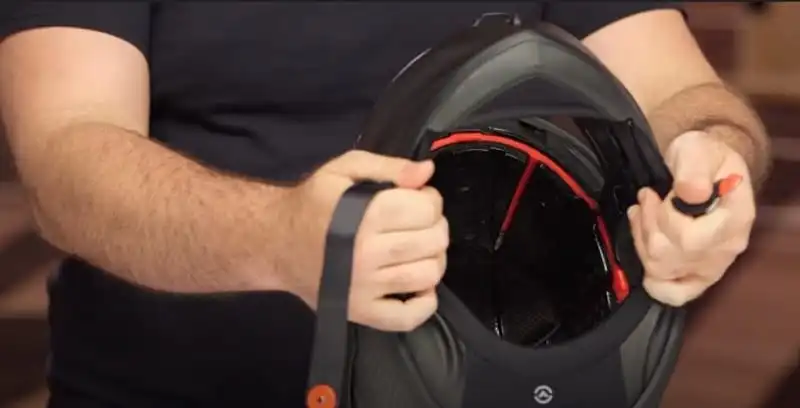This helmet is Bell’s latest top-line race helmet, and it shows that the company is still a pioneer today with the Bell Race Star DLX Flex.
The Race Star Flex DLX made big news when it was first revealed in 2014 because it introduced a new method of providing impact absorption.

Bell Race Star DLX Flex Review
Table of Contents
Impact Absorption
This helmet doesn’t rely entirely on expanded polystyrene or EPS in the liner. There’s still a section of that, but it’s one of three layers in this helmet.
There’s also a layer of expanded polyolefin or EPO, and one made from expanded polypropylene, also known as EPP.
The idea is that the three layers work together to help protect against a wider range of impact speeds than EPS alone can provide.
The EPO is most effective at absorbing low-speed impacts. EPP works best on medium-speed knocks, and EPS is there for the harder hits. If you have quite a low-speed impact, the EPO alone will deform to absorb it.
Hit it harder, and the EPO and EPP will both work to protect you. And if you hit your head hard enough, the EPS will compress too, and all three layers will work to absorb the impact energy.
That Flex liner can also move around slightly within the helmet shell, which Bell says helps it protect against injuries from glancing blows.
Because it can deflect slightly inside the shell, energy is spent on that movement, stopping that energy from being transferred to your brain. So that’s the truly novel part of the Race Star DLX Flex.
Shell Construction
The shell is made from all carbon fiber and has an aerodynamic spoiler around the back.
Shell Sizing
Bell Star Helmets are race-fit. Ingress, egress, and cheek pads are all snugger than on other Bell helmet models.
| Size | Head (CM) |
|---|---|
| XS | 53-54 |
| SM | 55-56 |
| MD | 57-58 |
| LG | 59-60 |
| XL | 61-62 |
| 2XL | 63-64 |
Weight
Carbon fiber is usually associated with the lightest of lids, but this motorcycle helmet weighs in on our scales at 1492 grams/3.75 lbs.
It’s a little above the average for a race helmet, but it’s still reasonable for helmet weight.
There is a lot of helmet in the Race Star DLX. It’s physically bigger than many other helmets, and I’d say that contributes to a little bit of the extra weight.

Ventilation
A comprehensive ventilation system runs through this helmet’s shell and liner.
The chin vent pulls air in and scoops it through the top of the chin bar, then two vents above the visor cool the top of the head.
This vent only clears the top of the visor, and the small central tab opens four intake holes.

The second shutter on top of the helmet opens to reveal a hole that allows air to flow down into the helmet through the lid and then out through the exit at the back of the helmet.
The venting on this helmet was effective when I tested it out on the road, especially the chin vent and the one above the visor.
These two vents sit farthest forward on the helmet, so it’s no surprise they get the most airflow.
I found with the lower of the two top vents that it was tricky to lift the opening tab if I didn’t have the visor locked down completely.
Visor
The visor on this lid is one of its strong points. It has great clarity and breadth of vision and is very easy to change. It has a central lifting tab, which is rapidly becoming the position of choice for visor tabs.
It locks in place by giving it a good solid click down. If you don’t click it down, it leaves a small gap to allow some air around the base of the visor.
But push it up any further, and it has to open all the way. So that lack of a half-stage opening is something some owners have raised as a bit of an issue.
Pinlock Anti-Fogging
The vise is protected against mist by a Pinlock 120 insert. That’s the middle of Pinlock’s three grades of insert in terms of moisture protection, and it’s supplied in the box with the helmet.
This helmet comes with a clear visor as standard; previously, the Race Star DLX had an additional tinted visor in the box.
In the future, the helmet will be supplied with Bell’s Pro-tint visor, which darkens in sunlight, and returns to clear as the light fades.
That will be a significant upgrade as there’s far less hassle of swapping visors for different conditions, even though it’s pretty simple to swap between the two.

Interior

The interior of this helmet is fully removable for washing, and the cheek pads are dead easy to fit as they’re attached with magnetic clips.
Intercom
There are recesses for intercom speakers, too; they’re filled with wedges of foam as standard, so pulling those out makes room for the speakers.
Bell has also left thinner sections at the top of the cheek pads to allow spectacle arms to fit comfortably.
Helmet Fastener
The strap fastener is a racy D-ring setup, and the covers that protect your skin from irritation can be removed for washing.
There’s one feature that Bell is among the few manufacturers to use: the tab that holds the loose strap end out of the way.
This secures against the base of the D-ring with a magnet, and that’s way quicker to use than the usual press studs you get on most helmets.
Safety Ratings
The approvals for the lid are ECE 2205 for road use, ACU gold for the track in Britain, and has maximum five-star performance in the UK government’s Sharp Safety scheme.
It also meets or exceeds Snell M2015 and DOT certifications.

What Customers Think
I have seen around 20 owner reviews for this lid, and riders are pleased with their purchase.
Some say they’ve had to go up a size from their normal choice, which I suspect is down to the interior shape of the lid.
Those riders who say they have what’s called an “intermediate oval head shape” are the people who find this lid the most comfortable.
That’s the shape of someone’s head when it’s slightly longer from front to back than wide from side to side.
My head is closest to a round head shape where you’ve got an equal distance front to back and side to side.
I found the Race Star DLX Flex slightly too short and also too narrow to be completely comfortable for me.
That was in the size medium, which I would normally take. However, I feel some people are going up a size if their heads are a bit too long or too wide to be comfortable with the internal shape of this helmet.
Finally, one last detail might appeal to some riders about this helmet.
It’s supplied with a classy helmet holdall, so if you’re transporting this lid, it’s much easier to carry it around in this bag with the handles that sit on the top than it is to carry it around in the normal drawstring bag that you get with most helmets.
In Conclusion
The Bell Race Star DLX Flex helmet is the lightest helmet Bell makes. It also features a new patented Panovision Raceview Viewport and a Panovision ProTint Photochromatic face shield.
This helmet is the perfect choice for riders looking for a lightweight, comfortable, aerodynamic helmet that’s easy to wear and ready to race right out of the box.
Where To Buy
Prices are correct at the time of writing this review. Always check both retailers below for special deals.



